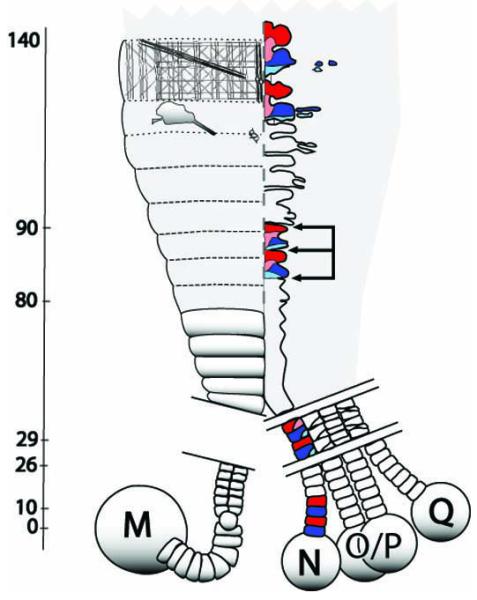Figure 1.

Schematic representation of the stem cell-mediated, lineage-dependent segmentation in the leech and other clitellate annelids. Anterior is to the top. Pairs of diagonal lines indicate discontinuities in the depicted structures. During cleavage (not illustrated), the D quadrant gives rise to one bilateral pair of mesodermal stem cells (M teloblasts) and four bilateral pairs of ectodermal stem cells (N, O/P, O/P and Q teloblasts). These constitute a cellularly defined posterior growth zone. Each teloblast undergoes several dozen highly unequal divisions producing columns (bandlets) of segmental founder cells (blast cells). Following the morphogenetic movements of gastrulation (not illustrated), the bandlets merge along the ventral midline (dotted line) in anteroposterior progression forming the germinal plate (gray shading), with older, more advanced blast cell clones at the anterior. Each of the five lineages contributes a stereotyped set of segmentally iterated progeny to the definitive segments. Thus, the timing of events in each lineage can be standardized by describing them in terms of the clonal age (cl.ag. indicated in hours on the axis), i.e., the time since the birth of the blast cell founding a given clone. For clarity, only the M lineage on the left side and the N lineage on the right side are shown here. The m blast cells undergo their first mitosis (indicated by a rounded cell in the bandlet) at 10 hours cl.ag.; the mitosis is oriented so that the daughter cells lie side by side within the bandlet. Prior to entering the germinal plate, m blast cell clones undergo several more divisions (not shown), giving rise to somites (solid and dotted contours). During subsequent development, each m blast cell clone interdigitates longitudinally with its neighbors, giving rise (by 140 hours cl.ag.) to a stereotyped complement of definitive progeny distributed over three segments; illustrated here are muscles (anteriormost meshwork), nephridia (irregular contour posterior to muscles) and a few ganglionic neurons (small contours near midline). In the N lineage, two types of blast cells, designated nf (blue) and ns (red) arise in exact alternation within the bandlet. These cells make their first divisions at different times (26 and 29 hours cl.ag., respectively) and with different degrees of asymmetry. Their definitive progeny comprise distinct sets of identifiable neurons and make up most of the segmental ganglia of the ventral nerve cord. A key event in the formation of discrete segmental ganglia is the partitioning of what are initially continuous columns of nf and ns progeny into separate ganglionic primorida. This occurs at roughly 80-90 hours cl.ag., as transverse fissures (3 arrows delimit 2 ganglionic primordia) separate the clones of cells derived from the posterior daughters of nf blast cells (nf.p, light blue) from those derived from the anterior daughters of ns blast cell (ns.a, pink).
